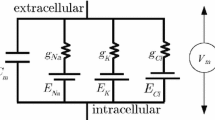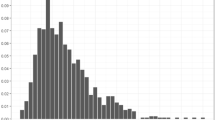Abstract
A theory has been developed which allows the estimation of the probability density of a discharge, given that an arbitrary condition is fulfilled. It is shown that the common methods for the evaluation of a post-stimulus time (PST) histogram and a hazard function can be considered as special applications of this theory. Whereas the usual hazard function shows how the probability of a discharge depends on the time elapsed since the last discharge, generalized hazard functions proposed in the present paper allow to reveal also the influence of the last but one discharge, the last but two discharge, and so on. In contrast to the usual method for the estimation of a hazard function, the applicability of the procedures proposed here is not restricted to stationary discharge activity. Some elementary applications are illustrated by analysing simulated discharge activity mimicing the response of a single auditory-nerve fiber to a high-intensity tone burst.
Similar content being viewed by others
References
Gaumond RP (1980) Studies of the stimulus and recovery dependence of cat cochlear nerve fiber spike discharge probability. D. Sc. thesis, Washington University, St. Louis, MO
Gaumond RP, Molnar CE, Kim DO (1982) Stimulus and recovery dependence of cat cochlear nerve fiber spike discharge probability. J Neurophysiol 48:856–873
Gaumond RP, Kim DO, Molnar CE (1983) Response of cochlear nerve fibers to brief acoustic stimuli: Role of discharge-history effects. J Acoust Soc Am 74:1392–1398
Gray PR (1966) A statistical analysis of electrophysiological data from auditory-nerve fibers in cat. M.I.T. Research Laboratory of Electronics, Technical Report 451, Cambridge, Mass
Gray PR (1967) Conditional probability analyses of the spike activity of single neurons. Biophys J 7:759–777
Knuth DE (1969) The art of computer programming, vol 2: Seminumerical algorithms. Addison-Wesley, Reading, Mass
Kumar A, Johnson DH (1984) The applicability of stationary point process models to discharge patterns of single auditorynerve fibers. Rice Univ. Dept. Elect. Engin. Tech. Rept. 84-09, Houston
Littlefield WM (1973) Investigation of the linear range of the peripheral auditory system. D.Sc. Thesis, St. Louis, MO
Lütkenhöner B, Hoke M, Bappert E (1980) Effect of recovery properties on the discharge pattern of auditory nerve fibers. Scand Audiol [Suppl] 11:25–43
Lütkenhöner B (1982) Wahrscheinlichkeitstheoretische Betrachtungen zum Entladungsverhalten von Hörnervenfasern. Doctoral thesis, University of Münster, Münster
Lütkenhöner B, Smith RL (1986) Rapid adaptation of auditory-nerve fibers: fine structure at high stimulus intensities. Hear Res 24:289–294
Miller MI (1985) Algorithms for removing recovery-related distortion from auditory-nerve discharge patterns. J Acoust Soc Am 77:1452–1464 (erratum 79:570)
Özdamar Ö, Dallos P (1978) Synchronous responses of the primary auditory fibers to the onset of tone burst and their relation to compound action potentials. Brain Res 155:169–175
Smith RL, Brachman ML (1980a) Dynamic response of single auditory-nerve fibers: some effects of intensity and time. In: van den Brink G, Bilsen FA (eds) Psychophysical, physiological and behavioural studies in hearing. Delft University Press, Delft, pp 312–319
Smith RL, Brachman ML (1980b) Operating range and maximum response of single auditory-nerve fibers. Brain Res 184:499–505
Snyder DL (1975) Random point processes. Wiley, New York
Westermann LA (1985) Adaptation and recovery of auditory nerve responses. Institute for Sensory Research, Special Report 24, Syracuse, NY
Author information
Authors and Affiliations
Rights and permissions
About this article
Cite this article
Lütkenhöner, B., Smith, R.L. A theoretical basis for conditional probability analyses of neural discharge activity. Biol. Cybern. 67, 1–10 (1992). https://doi.org/10.1007/BF00201797
Received:
Accepted:
Issue Date:
DOI: https://doi.org/10.1007/BF00201797




